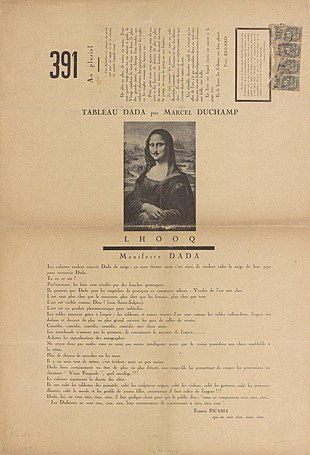

L.H.O.O.Q. (French pronunciation: [ɛl aʃ o o ky]) is a work of art by Marcel Duchamp. First conceived in 1919, the work is one of what Duchamp referred to as readymades, or more specifically a rectified ready-made.[2] The readymade involves taking mundane, often utilitarian objects not generally considered to be art and transforming them, by adding to them, changing them, or (as in the case of his most famous work Fountain) simply renaming and reorienting them and placing them in an appropriate setting.[3] In L.H.O.O.Q. the found object (objet trouvé) is a cheap postcard reproduction of Leonardo da Vinci's early 16th-century painting Mona Lisa onto which Duchamp drew a moustache and beard in pencil and appended the title.[4]
- ^ Marcel Duchamp 1887–1968, dadart.com
- ^ Marcel Duchamp, L.H.O.O.Q. or La Joconde, 1964 (replica of 1919 original) Norton Simon Museum, Pasadena.
- ^ Rudolf E. Kuenzli, Dada and Surrealist Film, MIT Press, 1996, p. 47, ISBN 026261121X
- ^ More recent scholarship suggests that Duchamp laboriously altered the postcard before adding the moustache, including merging his own portrait with that of Mona Lisa. See Marco de Martino, "Mona Lisa: Archived 20 March 2008 at the Wayback Machine Who Is Hidden Behind the Woman With the Moustache?"